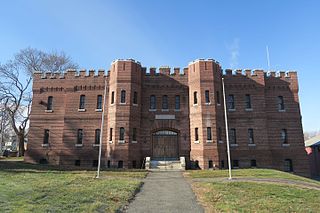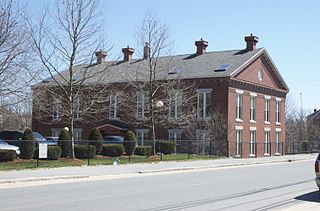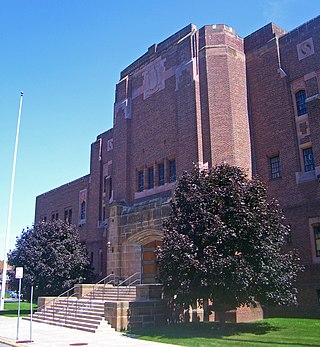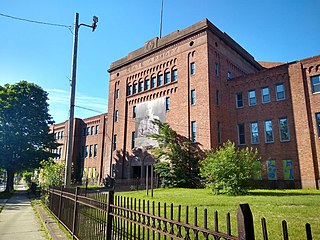
The Hudson Armory is a former Massachusetts Army National Guard armory and training center located at 35 Washington Street in Hudson, Massachusetts, United States. It is a castle-like, two-story brick masonry building built in 1910 at the intersection of Park Street and Washington Street in Hudson along the Assabet River. It was originally constructed for the Massachusetts Volunteer Militia. It was designed by architects James E. McLaughlin and James Mulcahy. As of June 2021, there are plans to convert the currently vacant armory into a community arts center.

West Concord station is an MBTA Commuter Rail station located in West Concord, Massachusetts. It is served by the Fitchburg Line. The station has two side platforms serving the line's two tracks, with mini-high platforms for accessibility. The adjacent station building, now a restaurant, is not used for railroad purposes.

The Armory of the First Corps of Cadets is a historic armory at 97–105 Arlington Street and 130 Columbus Avenue in Boston, Massachusetts. Over the years it has been known as Park Plaza Castle, Castle at Park Plaza, and The Tower.

The Armory, historically known as the First Regiment Armory Annex, and home to Portland Center Stage at The Armory, is a historic building with two theaters and is located in Portland, Oregon, United States. It was built in 1891 by Multnomah County to house the Oregon National Guard. In 2000, it was added to the National Register of Historic Places. Following a $36.1 million renovation project that lasted from 2002 to 2006, the building home to the theater company Portland Center Stage which produces 11 productions each season. An estimated 150,000 visitors visit The Armory annually to enjoy a mix of classical, contemporary and world premiere productions, along with the annual JAW: A Playwrights Festival, and a variety of high-quality education and community programs.

The Masonic Temple is an historic former Masonic building at 339–341 State Street in Springfield, Massachusetts. The four story Neo-Classical building was built in 1923 to serve as the headquarters of the local Masonic lodge. It occupies a prominent position opposite the Springfield Armory, just outside the downtown area. The building, which is no longer owned by the Masons, was listed on the National Register of Historic Places in 1983.

The State Armory is a historic armory building at 29 Howard Street in Springfield, Massachusetts. Built in 1895, it is a prominent and distinctive example of Gothic architecture in the city's downtown. The building was the first that was purpose-built for the local militia, and was in its later years home to the South End Community Center. It was listed on the National Register of Historic Places in 1976. It was extensively damaged by the Greater Springfield tornado on June 1, 2011, in which the rear drill shed of the building was reduced to rubble.

The Colburn School is a historic former school building at 136 Lawrence Street in Lowell, Massachusetts, USA. Built in 1848, it is a fine example of institutional Greek Revival architecture, and is one of the city's older surviving school buildings, built during the rapid population growth that followed the city's industrialization. Now converted to apartments, it was listed on the National Register of Historic Places in 1995.

The Schenectady Armory is located on Washington Avenue in the city of the same name in the U.S. state of New York. It is a brown brick building dating to 1936.

The 369th Regiment Armory is a historic National Guard Armory building located at 2366 Fifth Avenue, between West 142nd and 143rd Streets, in Harlem, Manhattan, New York City. It was built for the 369th Regiment, also known as the "Harlem Hellfighters", founded in 1913 as the first National Guard unit in New York State composed solely of African-Americans. It later became home to the 369th Sustainment Brigade.

Willimantic Armory is a historic armory building on Pleasant Street in Windham, Connecticut. It served the Connecticut National Guard from 1913 until 1980 when the building was sold to developers who converted the building into apartments.

The Commandant's Quarters at the Dearborn Arsenal is a United States military structure located at 21950 Michigan Avenue in Dearborn, Michigan. Built in 1834, it is the oldest building in Dearborn still located on its original site. It is considered to be one of the seven most significant buildings in Michigan. It was designated as a Michigan State Historic Site in 1956 and listed on the National Register of Historic Places in 1970.

The 14th Regiment Armory, also known as the Eighth Avenue Armory and the Park Slope Armory, is a historic National Guard armory building located on Eighth Avenue between 14th and 15th Streets in the South Slope neighborhood of Brooklyn, New York City, United States. The building is a brick and stone castle-like structure, and designed to be reminiscent of medieval military structures in Europe. It was built in 1891–95 and was designed in the Late Victorian style by William A. Mundell.

The Williamsport Armory is an historic National Guard armory complex that is located at 1300 Penn Street in Williamsport, Pennsylvania.

32nd St. and Lancaster Ave. Philadelphia Armory, also known as the 32nd Street Armory or Drexel Armory, is a historic National Guard armory and multipurpose venue located in the University City neighborhood of Philadelphia, Pennsylvania. Main entrances to the Armory are located at both 33rd and Cuthbert Street, and along Lancaster Walk. Cuthbert Street is part of the Armory property and was removed from Philadelphia city street listing. It was built in 1916, and is a trapezoidal-shaped building in the Classical Revival style. It is a three-story, 21,346 square foot, brick building with stone entablature and parapet. It houses administrative offices, a gymnasium, and drill hall. It was added to the National Register of Historic Places in 1991.

The Duluth Armory is a former armory and event venue in the East Hillside neighborhood of Duluth, Minnesota, United States. It was built in 1915 for the National Guard and naval militia, and expanded in 1941. From the beginning the National Guard also rented out the drill hall as an event venue, as it provided a larger and more flexible space than any other local venue until the construction of the Duluth Arena-Auditorium in 1966.

The District No. 9 Schoolhouse is a historic school building at 358 Hoyt Road in Gilford, New Hampshire. Built in 1815 and repeatedly altered to accommodated changing trends in school design, it is the best-preserved of Gilford's surviving district schoolhouses. Now a private summer residence, the building was listed on the National Register of Historic Places in 2000.

The William A. Paterson Factory Complex was a factory located at 126 East 3rd Street in Flint, Michigan. It was listed on the National Register of Historic Places in 1984. The building was demolished in 1996.

The Orange Armory is a historic armory building at 135 East Main Street in Orange, Massachusetts, United States. Built in 1913, it served as an organizing and station point for volunteer forces in World War I, and for state militia units into the 1960s. It was listed on the National Register of Historic Places in 2020.

The New Haven Armory is a historic building at 270–290 Goffe Street in the Dixwell neighborhood of New Haven, Connecticut, United States. Developed between 1928 and 1930, the armory served the Connecticut National Guard and the Second Company Governor's Foot Guard. It has also served as a venue for concerts, events, and other civic functions in the community.






















